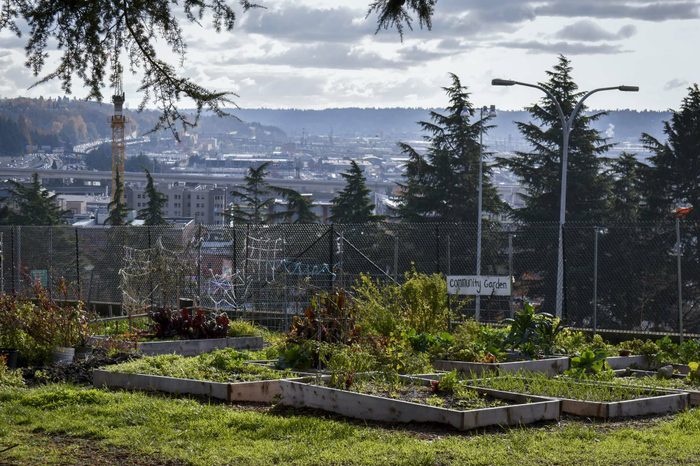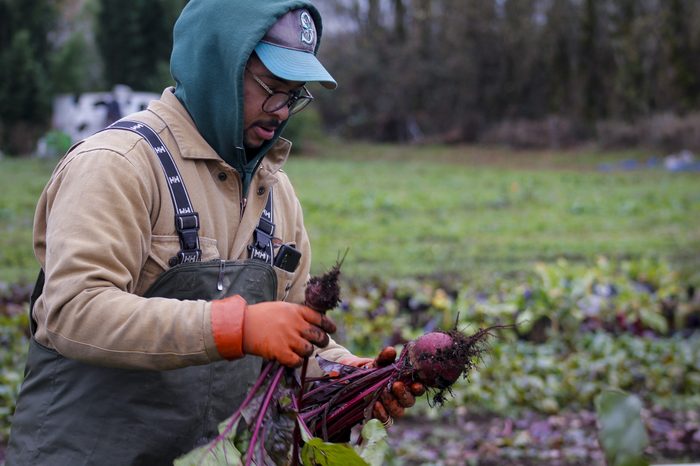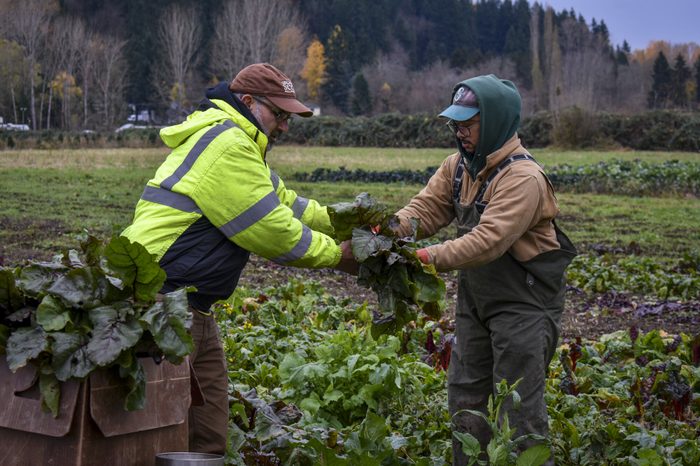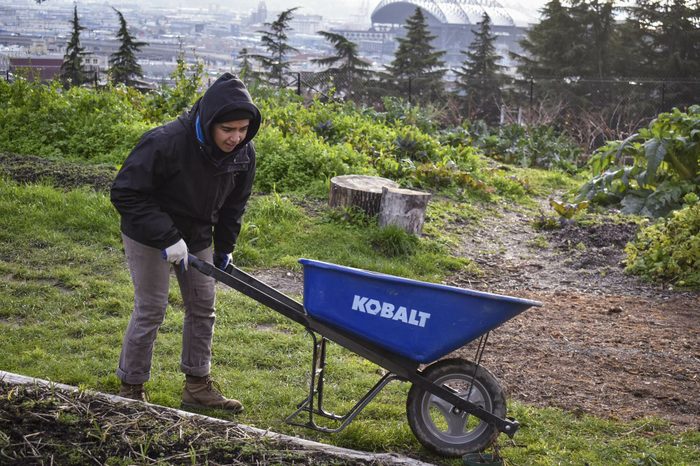Black Farmers Sow the Seeds for the Future
A century after the height of Black farming, young land stewards pick up the plow.
Randi Love

The trek across the Interstate 5 overpass is noisy, but once the small slope leading to the farm is in sight, nearly every sound melts away. Over the chain-link gate, a vibrant sky-blue greenhouse comes into view. A large sign atop the door reads, “Yes Farm.”
To the right is a busy construction site and towering condos and apartments. From the park just beyond comes the sounds of barking dogs and pickup basketball. Across the street, Seattle’s Harborview Medical Center completes an almost caged-off effect for the 700-yard strip of farmland. In the distance stands the downtown Seattle skyline.
On one fall day, a few city-goers walk leisurely through the accessible urban farm, where a volunteer shovels soil near a patch of greens.
“You can get your hands dirty a bit by coming out there or just seeing where your food is grown,” says Ray Williams, the managing director of Black Farmers Collective, a group of eight people who run two leased farms in western Washington. Yes Farm is the group’s urban location, not far from Seattle’s bustling Pike Place Market neighborhood. Small Axe Farm is about a 30-minute drive away.
Yes Farm is also home to a community garden “where folks who live in housing around here, or the neighborhood around here can get a bed or half a bed and grow their own food for their families,” says Hannah Wilson, farm manager.
The nonprofit, established in 2016, aims to educate the community and enrich the lives of Black people in and around the Seattle area through community gardens, events and participation. It operates with the assistance of volunteers who help plant, move soil and pack beds, but the heavy lifting is done by Williams, who identifies as biracial (Black and white), and his two full-time farm managers. The organic farms sell their goods through small community markets, and their crops include berries, cabbages, kale, beets and collard greens.
“I wanted to do something to help the Black community,” Williams says. “We hope that we can start to sell enough vegetables to become a model for a small farm operation. I don’t see us selling enough to pay for more than the growing of the food. We will always need grants and donations to offer our education, community events, and offer free food at pantries and special events.”

Daunting barriers for Black farmers
Black farmers in the United States have historically faced massive social and institutional barriers to owning and operating farms, according to a 2003 U.S. Department of Agriculture (USDA) Rural Business – Cooperative Service research report.
“For more than a century after the Civil War, deficient civil rights and various economic and social barriers were applied to maintaining a system where many [Black people] worked as farm operators with a limited and often total lack of opportunity to achieve ownership and operating independence,” the report says.
Eddie Moore, a Michigan State University agricultural professor and a former White House senior executive in the USDA during the Clinton administration, says the issues Black farmers face today date back to the Civil War. He says during that time, most resources and political power were in the South. Tobacco, cotton and other commodities were in high demand around the world. After slavery, many Black freedmen seeking work negotiated with the government and white planters for housing and land to cultivate. But Black farmers were often left with no other option than to become sharecroppers or tenants working for white farmers under discriminatory financial arrangements that left them grappling with a cycle of debt.
Moore says the expenses of cultivating the crops often far outweighed profit. “So basically even though [Black farmers] were involved in sharecropping, a lot of them were worse off than when they started these arrangements with white farmers,” Moore says.
While the late 19th and early 20th centuries were marked by economic stagnation for most Black farmers, according to the USDA, some were successful in their pursuit of independent farming enterprises.
Booker T. Washington emerged as a leading advocate to improve conditions and education for Black farmers, advocating for land-tract purchases for small farm families and a shift from cotton to fruits, vegetables, and livestock. Washington promoted crop diversification as an avenue towards self-sufficiency for Black farmers by avoiding dependence on cotton and indebtedness from crop liens, according to the USDA.
But the combination of new mechanization and the Great Depression reduced the demand for farm labor in the South, and by the New Deal era, the struggles of Black farmers to own land only increased. Under the Agricultural Adjustment Act of 1933 (AAA), meant to bolster a faltering economy, cotton production was supported by restricting acreage and guaranteeing minimum prices — but AAA programs primarily benefited white landowners.
Black farmers, meanwhile, often had to renegotiate to keep their land, while the cost of farmland increased 15 – 20%. Federal aid incentives to expand farm acreage grew, but Black farmers seldom had access to those programs.
Another major barrier for Black farmers has been access to timely and adequate loans, Moore says. The USDA has faced allegations of discriminatory lending practices, and in 2010, President Barack Obama settled a class action lawsuit that alleged that USDA discriminated against Black people who applied for farm loans and farm benefits between 1981 and 1996.
At the height of Black farming in 1920, Black-owned or operated farms accounted for approximately 15 million acres and 926,000 farms; by 2017, those numbers were down to 4.6 million acres and 35,470 farms, or about 1.4% of all U.S. agricultural producers, according to numbers from the USDA.
“The issue here is really that Black families, to a large extent, will never recoup that type of financial loss,” Moore says. “There is very little there for generations to come, or even the previous generations.”
Black farmers also make less money per farm than any other racial group. According to the USDA, Black farm producers in 2017 made an average net of $3,509 per farm; the overall national average was $43,053. The total market value of products sold by Black farm producers averaged $39,928 per farm; the national per-farm average was $190,245. And according to the National Agricultural Classification Survey, Black-operated farms sold just $1.4 billion of the $388 billion in U.S. agricultural products in 2017, just 0.4 percent of total U.S. sales.


Passing the plow to the next generation
In 2020, the rise of the Black Lives Matter movement brought systemic racism into the national conversation, garnering support for Black-owned businesses, including farms. But Black-owned or operated farms still face significant barriers when it comes to receiving federal aid, $4 billion of which, earmarked for Black farmers, is presently tied up in a pending lawsuit.
So farm operators like Ray Williams are looking for new ways to help the next generation of Black farmers move forward. As a former science teacher, Williams says he made the transition into farming after he gained a more defined connection between food and health as his career developed. After he helped form the Black Farmers Collective, he had a vision for what urban farming in Seattle could become.
“You don’t need to be part of the large corporate farming system, but you need an economic system that pays the farmer,” Williams says. “I was envisioning a cooperative urban farm where folks could come in and make a little bit of money off of what they’re doing.”
He says one goal of the collective is to obtain true sovereignty and ownership, but with the price of land in Washington, it’ll take some time to get there. “If we’re able to get into a position to be able to buy some land and continue to do this farming and then have something that could stay in the organization and could stay as a Black-owned land … [that] is something that I dream of, that we do talk about,” he says.
The 65-year-old plans to pass management over to his younger staff and board, who are all under 35, over the next couple of years, as he looks toward retirement.
Like Williams, many Black farmers in the United States are aging. In 2017, the average age for Black farmers was 60, underscoring the importance of training and resources for the next generation while more experienced farmers are still around to help.
Farm manager Hannah Wilson, for example, is 25. Wilson studied environmental science and geography at the University of Washington before working with Black Farmers Collective, initially to do restoration, which included clearing out invasive blackberries, and implementing the use of native plants to build a healthier ecosystem. “I was more on the environmental restoration side of things, talking about food justice and environmental racism and how that shows up in Seattle, but I hadn’t had a ton of experience actually farming yet,” Wilson says.
Wilson adds that farming offers an opportunity for authenticity while making an impact in the community. “I don’t have to try and be a certain way,” says Wilson, who is deaf and nonbinary. “I can do what I love and also bring all the disability, queerness, all of this into this space too — which is not something I felt like I could do growing up.”
Wilson gets excited about the future of Black farming and has hosted multiple community gatherings with Black chefs, book giveaways and partnerships with summer camps and afterschool programs. “I get to teach some kids a little bit more about farming, or the science behind farming, and that’s been really beautiful,” Wilson says.
Farm manager Masra Clamoungou, also 25, says he was never particularly interested in working on a farm growing up but has benefited from his Black Farmers Collective job physically, spiritually and mentally. He says growing up in Seattle didn’t expose him to wilderness or farms beyond what he saw on television, but elective classes at Seattle Central Colleges sparked an interest.
“There was a small sustainable food systems, sustainable agriculture program at that college, luckily,” says Clamoungou, who identifies as biracial (Black and white). “I randomly took a few classes there and they really spoke to me.” Clamoungou adds that he wants to help younger generations “preserve that culture of not just farming, but just being connected with ecosystems, connected with the land around them.”

Roots take hold for the future
Because most U.S. farms are family-owned, Williams says offering Black Farmers Collective to his staff after his retirement could be seen as a bit nontraditional — most land isn’t owned by a nonprofit and would traditionally be passed down to family members. And Williams confirms that land ownership is the group’s next big step, which would be a significant development.
“My hope is that we can develop the systems to make us sustainable and the shared skills to keep us moving forward,” Williams says. “I don’t have training in nonprofit development. I’ve just built [Black Farmers Collective] with hard work, greeting people with an open hand and a smile and lots of luck.”
Williams says Wilson is very capable of building a path for the organization that will help it move in the right direction, while Wilson hopes to bring in another generation of farmers to learn — before handing over the reins to build up a third farm.
Wilson also wants to create a learning space for people of color, building the opportunity to showcase Black leadership and have a community “with folks that look like you.”
Williams says he hopes his vision of the future expands beyond just what’s possible in one neighborhood.
“If you grow a plant in the pot, there’s only so far the roots can go. There’s only so big that plant can be,” he says. “If you can put the plant in the land, and those roots can stretch out and get the nutrition and experiences from that, then they can grow much larger and be way more fruitful.”
Randi Love is a graduate candidate at the Craig Newmark Graduate School of Journalism at CUNY and a Reuters-NABJ fellow.





